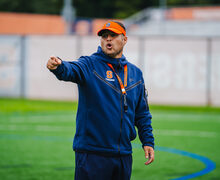How broadcasters keep up with Syracuse’s up-tempo offense
Jessica Sheldon | Photo Editor
Syracuse's up-tempo offense affects the way ESPN and other companies broadcast football games.
From inside the television production truck snuggled between the Carrier Dome and Sadler Hall, Ed Placey shook his head at what had just transpired: A replay but no snap.
In the Carrier Dome less than 100 yards away, Syracuse quarterback Eric Dungey had run up the middle for a first down across the Louisville 22-yard line in the first quarter. But viewers watching the game on ESPN did not see the snap live. They saw only a replay of running back Moe Neal, who four plays earlier ran for 16 yards, and the end of Dungey’s run, a mass of players piled on him.
“That shouldn’t happen,” said Placey, an ESPN senior coordinating producer for college football.
Opposing defenses aren’t the only ones tasked with adjusting to Syracuse’s fast-paced offense. Television producers, directors and broadcasters are challenged to keep up, altering how they deliver the game to viewers. Outside of the broadcast booth, the effects of speedy offenses are just as significant. Scoreboard and clock operators, public address announcers and spotters — those who assist the public address announcer — are all forced to be quicker.
Syracuse averaged one play every 18.4 seconds Friday night, several seconds faster than the NCAA average, which usually hovers around 24 seconds. SU ranks fourth in the FBS in plays per game, with 97. And, in recent years, a growing number of teams have implemented hurry-up offenses, including Oregon, Clemson and Syracuse. Auburn, Houston, Baylor and Arizona are among top programs that have run no-huddle offenses for years.
Television producers have to pick their spots to show replays, and broadcasters save player backstories for breaks in the action. In some cases, they ditch them altogether.
“No-huddle offense are not TV friendly at all,” said Anish Shroff, a broadcaster for ESPN. “You just gotta be on your toes a little more because you don’t want to miss anything.”
These teams play a style that's not conducive to replays. #TVproblems
— Anish Shroff (@AnishESPN) September 5, 2016
For broadcasters, hurry-up offenses mean economy of words, efficiency and more generalizations. With less time to talk between plays, it’s not uncommon for analysts, who break down plays, to not speak at length for several plays — even entire drives — at a time.
On Friday, ESPN sideline reporter Molly McGrath provided analysis mostly in and out of commercial breaks. With Syracuse and Louisville playing up-tempo, there was little time for McGrath to speak during the action.
“She can give us something that has meat, build off that instead of (me) starting out of a break,” said Adam Amin, an ESPN broadcaster who called Friday’s game. “When teams up the tempo, we can get good information in that way.”
There’s also a focus on prepared packages. With a team such as Nebraska that has an average-paced offense, ESPN can run a short montage directly after a play that breaks down the Xs and Os and intricacies of a scheme.
Shroff uses only 5 to 10 percent of his notes on air. For games with fast offenses, he may use only about 2 percent of his prepared notes. And while Shroff prepares the same way no matter the offenses, he’s tasked with speaking in brevity: He meshes more into shorter periods. For example, he may say:
“Three-star recruit Eric Dungey with the 5-yard gain,” as opposed to, “Dungey, with the keep, a gain of five. The three-star recruit…”
“You’re not giving the 505 story but rather the 101 version of the story,” Shroff said.
Dennis Deninger, a professor of sport management at SU, said the time pressure for radio is probably more intense because broadcasters have to describe the action to listeners. Matt Park, the radio play-by-play voice for Syracuse IMG Sports Network, calls SU football and men’s basketball.
During pauses in the game, Park breaks down what happened in the previous series. Sneaking themes of the game or bigger picture ideas is “probably not wise,” he said. Substitutions provide a chance to slide in a little more commentary between plays.
In the end, what’s relevant in the moment is paramount. Between plays, he might jump in and note that Ervin Philips has tied the SU record for catches in a game. But when the game picks up in cadence and flow, so does Park.
“If the game is slow, we’ll sound slow,” he said. “If the game is up tempo, we’ll sound snappy.”
Before each game they broadcast, ESPN producers, directors and broadcasters meet with each team’s coaching staff. Bryan Jaroch, a producer with the network, asks what type of tempo he can expect for the game. If a team plans to run up-tempo, producers may prepare fewer graphics because they likely won’t have the time to air them during the game.
“Graphics — you just can’t do it,” said Bryan Ryder, an ESPN producer. “It’s annoying. It drives me nuts when a graphic is in there for two seconds and you can’t read it.”
On the bottom right of the screen, ESPN places a “bug,” or the square that shows the score, down, clock and yards to go. Ryder calls it an asset for ESPN, as producers can flash third down conversion rates, total yardage and other simple measures.
Courtesy of ESPN3
Deninger compared hurry-up offenses to hockey, where viewers don’t see as many replays and graphics. Graphics are limited to the lower third because full screen graphics take time to process. Producers use natural breaks, commercials, to integrate what are called in-bumps, or analysis and graphics.
“It’s a completely different approach,” Deninger said. “You just have to cover what’s happening. For most of us in television sports, that runs counter to what we want to do.”
What ESPN crews execute to fit more replays into telecast is a “two-box.” One box on the screen shows the live picture, or what’s happening on the field. The other shows the replay. This lets producers and directors squeeze in replays, even in high-paced action.
The screens are condensed, limiting in the variety of shots directors can choose. Only certain angles fit in a downsized box. Often, producers scrap replays on no-huddle drives.
Courtesy of ESPN3
When full-screen replays are shown, they’re sometimes shortened. Shots may include only the final stage of the play. In the first two weeks of college football, however, ESPN has occasionally cut to full-screen replays, missing out on snaps, producer Andrew Bock said. Missing snaps is a “cardinal sin” because it cuts down on action for viewers.
“It’s really taken us a few years to get it down to a science,” Bock said. “It still hasn’t been perfected. Even the Houston-Oklahoma game, I know the guy producing that game (and) there were some phenomenal plays, but he missed some snaps early on.”
The results are amplified in the red zone. Choosing to cut to a shot away from the main action for a third or fourth time between plays might lead to a missed snap. All the viewer is left to see is the player walking into the end zone, rather than the entire play.
On Friday night, Michael Veley and Patrick Ryan were stationed near Amin. Veley, SU’s public address announcer, and Ryan, his spotter, changed the way they prepared for the Orange’s season opener against Colgate — they didn’t.
Typically, Ryan marks up the starters, second string team and captains. But once the Colgate game started, he knew he would never look at the sheet. There was simply no time.
“My head’s still spinning,” Ryan said four days after the Colgate game, slightly joking. “It’s craziness.”
Ryan, an instructor of sport management at SU, works beside Veley with the rosters and a pair of binoculars. After each play, he tells Veley what happened — the players involved, yards lost or gained, the ball’s spot on the field, the down and yards to go.
Ryan is especially important with the fast offense, as Veley had no rehearsal. There were no exhibition games for him to practice announcing the offense. Veley has to describe everything that happens plays before the team lines ups the next snap.
“It’s just rush, rush, rush,” Bock said. “You want to enhance the game but you also don’t want to interrupt that. Remembering the game is sacred is even more important when covering high-speed offenses.
“It’s really difficult.”
Published on September 12, 2016 at 12:32 am
Contact Matthew: [email protected] | @MatthewGut21






